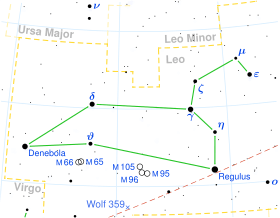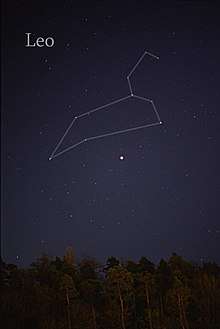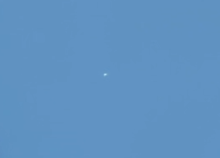Regulus
Regulus UK: /ˈrɛɡˌjulʊs/ US: /ˈrɛɡˌjʊlʊsˌ/,[15] designated α Leonis (Latinized to Alpha Leonis, abbreviated Alpha Leo, α Leo), is the brightest object in the constellation Leo and one of the brightest stars in the night sky, lying approximately 79 light years from the Sun. Regulus appears singular, but is actually a quadruple star system composed of four stars that are organized into two pairs. The spectroscopic binary Regulus A consists of a blue-white main-sequence star and its companion, which has not yet been directly observed, but is probably a white dwarf. HD 87884 is separated from Regulus by 176″ and is itself a close pair. Regulus, along with 5 slightly dimmer stars Zeta Leonis, Mu Leonis, Gamma Leonis, Epsilon Leonis and Eta Leonis have collectively been called 'the Sickle', which is an asterism that marks the head of Leo.
 Location of Regulus in Leo | |
| Observation data Epoch J2000 Equinox J2000 | |
|---|---|
| Constellation | Leo |
| Regulus A | |
| Right ascension | 10h 08m 22.311s[1] |
| Declination | +11° 58′ 01.95″[1] |
| Apparent magnitude (V) | 1.40[2] |
| Regulus BC | |
| Right ascension | 10h 08m 12.8/14s[3] |
| Declination | +11° 59′ 48″[3] |
| Apparent magnitude (V) | 8.13[4]/13.50[4] |
| Characteristics | |
| Regulus A | |
| Evolutionary stage | Subgiant |
| Spectral type | B8 IVn[2] |
| U−B color index | –0.36[5] |
| B−V color index | –0.11[5] |
| Variable type | Suspected[6] |
| Regulus BC | |
| Evolutionary stage | Main sequence |
| Spectral type | K2 V[7] + M4 V[7] |
| U−B color index | +0.51[5] |
| B−V color index | +0.86[5] |
| Astrometry | |
| Radial velocity (Rv) | +5.9/+6.3[8] km/s |
| Proper motion (μ) | RA: −248.73±0.35[1] mas/yr Dec.: 5.59±0.21[1] mas/yr |
| Parallax (π) | 41.13 ± 0.35[1] mas |
| Distance | 79.3 ± 0.7 ly (24.3 ± 0.2 pc) |
| Absolute magnitude (MV) | –0.57[9]/6.3/11.6 |
| Details | |
| α Leo A | |
| Mass | 3.8[10] M☉ |
| Radius | 3.092±0.147[2] R☉ |
| Luminosity | 288[10] L☉ |
| Surface gravity (log g) | 3.54±0.09[11] cgs |
| Temperature | 12,460±200[10] K |
| Rotational velocity (v sin i) | 318±8[12] km/s |
| Age | ≳1[13] Gyr |
| α Leo B | |
| Mass | 0.8[14] M☉ |
| Luminosity | 0.50[14] L☉ |
| Surface gravity (log g) | 4.4[14] cgs |
| Temperature | 4885[14] K |
| α Leo C | |
| Mass | 0.3[4] M☉ |
| Other designations | |
| α Leo A: BD+12°2149, HD 87901, LTT 12716, SAO 98967 | |
| α Leo B/C: BD+12°2147, HD 87884, LTT 12714, SAO 98966 | |
| Database references | |
| SIMBAD | Regulus |
| BC | |
Nomenclature

α Leonis (Latinized to Alpha Leonis) is the star system's Bayer designation. The traditional name Rēgulus is Latin for 'prince' or 'little king'. In 2016, the International Astronomical Union organized a Working Group on Star Names (WGSN)[16] to catalog and standardize proper names for stars. The WGSN's first bulletin of July 2016[17] included a table of the first two batches of names approved by the WGSN; which included Regulus for this star. It is now so entered in the IAU Catalog of Star Names.[18]
Observation
The Regulus system as a whole is the twenty-first brightest star in the night sky with an apparent magnitude of +1.35. The light output is dominated by Regulus A. Regulus B, if seen in isolation, would be a binocular object of magnitude +8.1, and its companion, Regulus C, the faintest of the three stars that has been directly observed, would require a substantial telescope to be seen, at magnitude +13.5. Regulus A is itself a spectroscopic binary; the secondary star has not yet been directly observed as it is much fainter than the primary. The BC pair lies at an angular distance of 177 arc-seconds from Regulus A, making them visible in amateur telescopes.[19]

Regulus is 0.465 degrees from the ecliptic,[20] the closest of the bright stars, and is regularly occulted by the Moon. Occultations by Mercury and Venus are possible but rare, as are occultations by asteroids. Seven other stars which have a Bayer designation are less than 0.9° from the ecliptic (perfected, mean plane of earth's orbit and mean apparent path of the sun) the next brightest of which is δ (Delta) Geminorum, of magnitude +3.53. As Regulus closely aligns to the mean orbits of most significant objects of the solar system and is of many times greater magnitude than its comparators, the system has advanced telescopic use (to study and identify objects which may be its orbit) such as when it is occulted by a known asteroid and in observing the shadowing formed by any intermediate solar system matter, including asteroids.
The last occultation of Regulus by a planet was on July 7, 1959, by Venus.[21] The next will occur on October 1, 2044, also by Venus. Other planets will not occult Regulus over the next few millennia because of their node positions. An occultation of Regulus by the asteroid 166 Rhodope was observed by 12 researchers from Portugal, Spain, Italy, and Greece on October 19, 2005. Differential bending of light was measured to be consistent with general relativity.[22] Regulus was occulted by the asteroid 163 Erigone in the early morning of March 20, 2014.[23] The center of the shadow path passed through New York and eastern Ontario, but no one is known to have seen it, due to cloud cover. The International Occultation Timing Association recorded no observations at all.[24]
Although best seen in the evening in the northern hemisphere's late winter and spring, Regulus appears at some time of night throughout the year except for about a month (depending on ability to compensate for the sun's glare, ideally done so in twilight) on either side of August 22–24, when the Sun overlaps.[25] Thus the star can be viewed the whole night, crossing the sky, in late February. Regulus passes through SOHO's LASCO C3 when the sun overlaps.[26] For most Earth observers, the heliacal rising (pre-sunrise appearance) of Regulus occurs in the first week of September. Every 8 years, Venus near-occults the star system around that time, as on 5 September 2014.
Stellar system
Regulus is a multiple star system consisting of at least four stars. Regulus A is the dominant star, with a binary companion 177" distant that is thought to be physically related. Regulus D is a 12th magnitude companion at 212",[27] but is an unrelated background object.[28]
Regulus A is a binary star consisting of a blue-white main sequence star of spectral type B7V, which is orbited by a star of at least 0.3 solar masses, which is probably a white dwarf. The two stars take approximately 40 days to complete an orbit around their common centre of mass. Given the extremely distorted shape of the primary, the relative orbital motion may be notably altered with respect to the two-body purely Keplerian scenario because of non-negligible long-term orbital perturbations affecting, for example, its orbital period. In other words, Kepler's third law, which holds exactly only for two point-like masses, would no longer be valid for the Regulus system. Regulus A was long thought to be fairly young, only 50 – 100 million years old, calculated by comparing its temperature, luminosity, and mass. The existence of a white dwarf companion would mean that the system is at least 1 billion years old, just to account for the formation of the white dwarf. The discrepancy can be accounted for by a history of mass transfer onto a once-smaller Regulus A.[13]
The primary of Regulus A has about 3.5 times the Sun's mass. It is spinning extremely rapidly, with a rotation period of only 15.9 hours, which causes it to have a highly oblate shape.[29] This results in so-called gravity darkening: the photosphere at Regulus' poles is considerably hotter, and five times brighter per unit surface area, than its equatorial region.[13] The star's surface at the equator rotates at about 320 kilometres per second (199 miles per second), or 96.5% of its critical angular velocity for break-up. It is emitting polarized light because of this.[12]
Regulus BC is 5,000 AU[30] from Regulus A. They share a common proper motion and are thought to orbit each other.[4] Designated Regulus B and Regulus C, the pair has Henry Draper Catalogue number HD 87884. The first is a K2V star, while the second is about M4V.[29] The companion pair has an orbital period of about 600 years[4] with a separation of 2.5" in 1942.[29]
Etymology and cultural associations
Rēgulus is Latin for 'prince' or 'little king';[31] its Greek equivalent (Latinised) is Basiliscus.[32][33] It is also known as Qalb al-Asad, from the Arabic قلب الأسد, meaning 'the heart of the lion', a name already attested in the Greek Kardia Leontos[32][34] whose Latin equivalent is Cor Leōnis. The Arabic phrase is sometimes approximated as Kabelaced. In Chinese it is known as 轩辕十四, the Fourteenth Star of Xuanyuan, the Yellow Emperor. In Indian astronomy, Regulus corresponds to the Nakshatra Magha ("the bountiful").
Babylonians called it Sharru ("the King"), and it marked the 15th ecliptic constellation. In India it was known as Maghā ("the Mighty"), in Sogdiana Magh ("the Great"), in Persia Miyan ("the Centre") and also as Venant, one of the four 'royal stars' of the Persian monarchy.[35] It was one of the fifteen Behenian stars known to medieval astrologers, associated with granite, mugwort, and the kabbalistic symbol ![]()
In the Babylonian MUL.APIN, Regulus is listed as Lugal, meaning king, with co-descriptor, "star of the Lion's breast".[36]
References
- van Leeuwen, F. (2007). "Validation of the new Hipparcos reduction". Astronomy and Astrophysics. 474 (2): 653–664. arXiv:0708.1752. Bibcode:2007A&A...474..653V. doi:10.1051/0004-6361:20078357. Vizier catalog entry
- van Belle, Gerard T.; von Braun, Kaspar (2009). "Directly Determined Linear Radii and Effective Temperatures of Exoplanet Host Stars". The Astrophysical Journal. 694 (2): 1085–1098. arXiv:0901.1206. Bibcode:2009ApJ...694.1085V. doi:10.1088/0004-637X/694/2/1085.
- Høg, E.; Fabricius, C.; Makarov, V. V.; Urban, S.; Corbin, T.; Wycoff, G.; Bastian, U.; Schwekendiek, P.; Wicenec, A. (2000). "The Tycho-2 catalogue of the 2.5 million brightest stars". Astronomy and Astrophysics. 355: L27. Bibcode:2000A&A...355L..27H. doi:10.1888/0333750888/2862. ISBN 978-0333750889.
- Tokovinin, A. A. (1997). "MSC – a catalogue of physical multiple stars". Astronomy and Astrophysics Supplement Series. 124: 75–84. Bibcode:1997A&AS..124...75T. doi:10.1051/aas:1997181.
- Ducati, J. R. (2002). "VizieR Online Data Catalog: Catalogue of Stellar Photometry in Johnson's 11-color system". CDS/ADC Collection of Electronic Catalogues. 2237: 0. Bibcode:2002yCat.2237....0D.
- Samus, N. N.; Durlevich, O. V.; et al. (2009). "VizieR Online Data Catalog: General Catalogue of Variable Stars (Samus+ 2007–2013)". VizieR On-line Data Catalog: B/GCVS. Originally Published in: 2009yCat....102025S. 1: 02025. Bibcode:2009yCat....102025S.
- Gies, D.R.; Dieterich, S.; Richardson, N. D.; Riedel, A. R.; Team, B. L.; McAlister, H. A.; Bagnuolo, Jr., W. G.; Grundstrom, E. D.; Štefl, S.; Rivinius, Th.; Baade, D.; et al. (2008). "A Spectroscopic Orbit for Regulus". The Astrophysical Journal. 682 (2): L117–L120. arXiv:0806.3473. Bibcode:2008ApJ...682L.117G. doi:10.1086/591148.
- Evans, D. S. (1967). "The Revision of the General Catalogue of Radial Velocities". Determination of Radial Velocities and Their Applications. 30: 57. Bibcode:1967IAUS...30...57E.
- Anderson, E.; Francis, Ch. (2012). "XHIP: An extended hipparcos compilation". Astronomy Letters. 38 (5): 331. arXiv:1108.4971. Bibcode:2012AstL...38..331A. doi:10.1134/S1063773712050015.
- Malagnini, M. L.; Morossi, C. (November 1990). "Accurate absolute luminosities, effective temperatures, radii, masses and surface gravities for a selected sample of field stars". Astronomy and Astrophysics Supplement Series. 85 (3): 1015–1019. Bibcode:1990A&AS...85.1015M.
- Fitzpatrick, E. L.; Massa, D. (March 2005). "Determining the Physical Properties of the B Stars. II. Calibration of Synthetic Photometry". The Astronomical Journal. 129 (3): 1642–1662. arXiv:astro-ph/0412542. Bibcode:2005AJ....129.1642F. doi:10.1086/427855.
- Cotton, Daniel V; Bailey, Jeremy; Howarth, Ian D; Bott, Kimberly; Kedziora-Chudczer, Lucyna; Lucas, P. W; Hough, J. H (2017). "Polarization due to rotational distortion in the bright star Regulus". Nature Astronomy. 1 (10): 690–696. arXiv:1804.06576. Bibcode:2017NatAs...1..690C. doi:10.1038/s41550-017-0238-6.
- Rappaport, S.; Podsiadlowski, Ph.; Horev, I. (2009). "The Past and Future History of Regulus". The Astrophysical Journal. 698 (1): 666–675. arXiv:0904.0395. Bibcode:2009ApJ...698..666R. doi:10.1088/0004-637X/698/1/666.
- Martin, E. L.; Magazzu, A.; Rebolo, R. (1992). "On the post-T-Tauri nature of late-type visual companions to B-type stars". Astronomy and Astrophysics. 257: 186. Bibcode:1992A&A...257..186M.
- "regulus". Oxford English Dictionary (3rd ed.). Oxford University Press. September 2005. (Subscription or UK public library membership required.)
- "IAU Working Group on Star Names (WGSN)". Retrieved 22 May 2016.
- "Bulletin of the IAU Working Group on Star Names, No. 1" (PDF). Retrieved 28 July 2016.
- "IAU Catalog of Star Names". Retrieved 28 July 2016.
- Pugh, Philip (2009). "Simple Deep Sky Viewing". The Science and Art of Using Telescopes. Patrick Moore's Practical Astronomy Series. pp. 157–185. doi:10.1007/978-0-387-76470-2_6. ISBN 978-0-387-76469-6.
- "Zodiac Stars". John Pratt's stars. Retrieved 2019-06-23.
- "Occultations of bright stars by planets between 0 and 4000". Retrieved 2007-10-16.
- Sigismondi, Costantino; Troise, Davide (2008). "Asteroidal Occultation of Regulus:. Differential Effect of Light Bending". THE ELEVENTH MARCEL GROSSMANN MEETING on Recent Developments in Theoretical and Experimental General Relativity: 2594–2596. Bibcode:2008mgm..conf.2594S. doi:10.1142/9789812834300_0469. ISBN 9789812834263.
- Sigismondi, C.; Flatres, T.; George, T.; Braga-Ribas, F. (2014). "Stellar limb darkening scan during 163 Erigone asteroidal occultation of Regulus on March 20, 2014 at 6:06 UT". The Astronomer's Telegram. 5987: 1. Bibcode:2014ATel.5987....1S.
- "Regulus 2014". International Occultation Timing Association. Retrieved 2019-06-23.
- "In the Sky". Retrieved 2019-06-23.
- Battams, Karl. "Notable objects in LASCO C3". Sungrazing Comets. Navy.mil. Retrieved 2012-09-05.
- Mason, Brian D.; Wycoff, Gary L.; Hartkopf, William I.; Douglass, Geoffrey G.; Worley, Charles E. (2001). "The 2001 US Naval Observatory Double Star CD-ROM. I. The Washington Double Star Catalog". The Astronomical Journal. 122 (6): 3466–3471. Bibcode:2001AJ....122.3466M. doi:10.1086/323920.
- Brown, A. G. A.; et al. (Gaia collaboration) (August 2018). "Gaia Data Release 2: Summary of the contents and survey properties". Astronomy & Astrophysics. 616. A1. arXiv:1804.09365. Bibcode:2018A&A...616A...1G. doi:10.1051/0004-6361/201833051. Gaia DR2 record for this source at VizieR.
- McAlister, H. A.; ten Brummelaar, T. A.; Gies; Huang; Bagnuolo, Jr.; Shure; Sturmann; Sturmann; Turner; Taylor; Berger; Baines; Grundstrom; Ogden; Ridgway; Van Belle; et al. (2005). "First Results from the CHARA Array. I. An Interferometric and Spectroscopic Study of the Fast Rotator Alpha Leonis (Regulus)". The Astrophysical Journal. 628 (1): 439–452. arXiv:astro-ph/0501261. Bibcode:2005ApJ...628..439M. doi:10.1086/430730.
- Lindroos, K. P. (1985). "A study of visual double stars with early type primaries. IV Astrophysical data". Astronomy and Astrophysics Supplement Series. 60: 183. Bibcode:1985A&AS...60..183L.
- regulus. Charlton T. Lewis and Charles Short. A Latin Dictionary on Perseus Project.
- Geminus; James Evans; J. L. Berggren (29 October 2006). Geminos's Introduction to the Phenomena: A Translation and Study of a Hellenistic Survey of Astronomy. Princeton University Press. ISBN 978-0-691-12339-4.
- βασιλίσκος. Liddell, Henry George; Scott, Robert; A Greek–English Lexicon at the Perseus Project.
- καρδία in Liddell and Scott.
- Allen, Richard Hinckley (1963). Star Names: Their Lore and Meaning. Dover. pp. 255–6. ISBN 978-0-486-21079-7.
- Rogers, J. H. (February 1998). "Origins of the ancient constellations: I. The Mesopotamian traditions". Journal of the British Astronomical Association. 108 (1): 9–28. Bibcode:1998JBAA..108....9R.
External links
| Wikimedia Commons has media related to Regulus (star). |
- "Regulus 3". SolStation. Retrieved December 1, 2005.